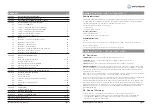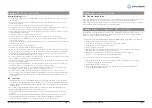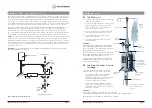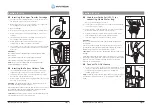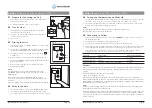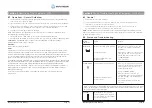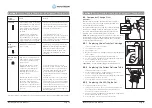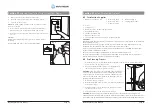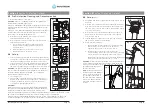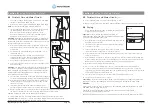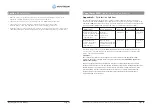
Operating Instruction Manual
Page 15
Fig. 1
Fig. 3
Section 6
Alarms, Trouble Shooting and Component Change-Outs
6.3
Component Change Outs
WARNINGS:
The vapor transfer cartridge, patient delivery tube, and VSS-1
spike set are all single use only and should be discarded after
removal from the Vapotherm 2000i.
The Patient Delivery Tube, VSS-1 and Vapor Transfer Cartridge
should not be changed or replaced in the patient care area.
The system must be disinfected any time the Vapor Transfer
Cartridge, VSS-1 or Patient Delivery Tube are removed.
NOTE:
The cannula and sterile water source can be replaced without
disinfecting the system. As with all respiratory equipment, proper
hand washing techniques should be followed before contacting
or replacing any patient interfaces.
6.3.1
Replacing Vapor Transfer Cartridge
1. Power off unit. Disconnect gas flow.
2. Close clip on VSS-1.
(Fig. 1)
3. Open hinged cover.
4. Disconnect air tubes from cartridge ends by pressing tubing away
from cartridge.
5. Remove cartridge by pulling straight outwards.
(Fig. 2)
6. Proceed to Section 8.0 and disinfect the Vapotherm
®
2000i device
before returning the device to service.
7. For set-up please refer to Section 4.3 of the manual.
CAUTION:
Do not grip cartridge tubing with sharp instruments.
6.3.2
Replacing the Patient Delivery Tube
1. Power unit off. Disconnect gas flow.
2. To remove tube, push base of tube upwards, rotate 1/4 turn
counter clockwise and pull downward.
(Fig. 3)
3. Proceed to Section 8.0 and disinfect the Vapotherm
®
2000i device
before returning the device to service.
4. For set-up please refer to Section 4.4 of the manual.
6.3.3
Replacing the VSS-1 Spike Set
1. Power off unit. Disconnect gas flow.
2. Clamp VSS-1 and remove VSS-1 Spike Set from the water inlet
port on the back of the Vapotherm 2000i by releasing the
quick connect on the water inlet port.
3. Proceed to Section 8.0 and disinfect the Vapotherm
®
2000i device
before returning the device to service.
4. For set-up please refer to Section 4.5 of the manual.
Fig. 2
Alarm
Cause
Action
indication
Operating Instruction Manual
Page 14
If further assistance is needed please call your clinical product specialist or local distributor representative.
S
S
If the Cartridge Alarm is continuous
and air bubbles are rising into the
VSS-1 bubble trap or if a flow or
water is visible in the tube below
the cartridge, then the cartridge
has failed.
If cartridge alarm is intermittent
and there are no bubbles in the
VSS-1 bubble trap or no obvious
water flow below the cartridge there
may be condensation in the system.
First disconnect the patient from the unit,
shut down unit, drain unit, disinfect unit,
replace cartridge, VSS-1 and delivery tube,
and follow set up instructions.
Occasional brief alarms due to
condensation are not a cause for concern.
Try briefly pinching and releasing tube
under cartridge to dislodge the drops and/
or decrease set temperature.
Cartridge
Malfunction of Temperature
Control System.
Shut down system and return for service.
NOTE:
A momentary High Temperature
alarm may occur when the unit has
been switched off and on again. If the
temperature then stabilizes, no action
is needed.
High
Temperature
Alarm
High water or air pressure due to
high resistance in water circulation
or air outlet: or malfunctioning
pressure sensor.
Blocked tube alarm due to high
WATER pressure will cause a
continuous or intermittent tone
and alarm light. The flow of
breathing gas continues, but is
no longer heated.
Blocked tube alarm due to high
GAS pressure will cause a 5 second
alarm tone. If the obstruction
persists the system will continue
to alarm in 5 sec episodes. Water
circulation continues but the heater
shuts off.
Check that delivery tube is correctly
positioned, rotated clockwise, and pulled
into locked position. Check that water is
circulating within delivery tube. If alarm
persists replace delivery tube and/or
cartridge. Disinfect unit prior to replacing
components.
Find and correct the cause of obstruction.
The most common cause is a kink in the
nasal cannual or in the prong. Attempting
to run the Vapotherm 2000i at very high
flow through a patient interface not
approved by Vapotherm may also raise the
internal pressure sufficiently to trigger a
Blocked Tube Alarm.
Blocked Tube
Alarm
S
Section 6
Alarms, Trouble Shooting and Component Change-Outs
Содержание 2000i
Страница 1: ...2000i Operating Instruction Manual...


